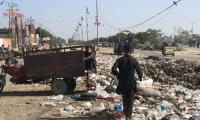June 26 marks the International Day against Drug Abuse and Illicit Trafficking. The day was decided by the United Nations General Assembly in 1987 to raise the level of awareness in the international community about the dangers of drug abuse, to prevent its spread and to encourage all efforts to combat the menace at international level.
Terrorism, drugs-for-arms and money laundering, intrinsically linked, pose a considerable threat to global peace and security besides destabilising the political and financial stability of many nation-states. These issues became more common after 9/11.
Militants and extremists have a nexus with criminal networks involved in drug and the arms trade. Evidence available with intelligence agencies confirms that, from Al-Qaeda to Isis, the real challenge is that of free flow of legal and illegal funds. And till today, the international community has failed to sever their financial lifeline.
It is an open secret how the drug trade in post-Taliban Afghanistan was institutionalised – courtesy the puppet regime in Kabul and patronisation of war lords in many provinces of Afghanistan. Once opium started being processed into morphine and heroin inside Afghanistan at a mass scale, it brought tons of money for commanders on the ground.
The controlled democracy in Afghanistan since 2004 has been playing into the hands of more sophisticated narco-enriched commanders. It is no more a secret that the Taliban, with whom the US and allies have always been in negotiation, knew how to buy or muscle a vote which would protect their opium interests in every election.
Even Afghanistan’s neighbours have been making profits from the windfall. According to the UN, criminal groups from Central Asia made profits of $15.2 billion from the trafficking of opiates in 2015. Tajikistan is by far the worst affected by the drug plague, due to a combination of history, poverty and geography.
In the late 1990s, the drug trade was believed to be a source of finance for the Islamic Movement of Uzbekistan (IMU), a terrorist group which had bases in Afghanistan and Tajikistan. After the war in Afghanistan, the IMU lost most of its influence, but the drug trade continued, with organised criminals taking the place of political or religious activists.
In a survey conducted by the Open Society Institute, eight out of ten of those polled said, hardly surprisingly, that “the main reason to turn to drug trafficking was to make big money”. Geography also contributed to Tajikistan’s drugs problem: at 1,400km, the country’s border with Afghanistan is longer than its Central Asian neighbours’, and commensurately more difficult to guard.
Afghanistan’s north-eastern province of Badakhshan, an important poppy-growing area, is close to the border with Tajikistan. From there, most narcotics move to Uzbekistan and Kyrgyzstan before continuing to Kazakhstan and onwards to Russia.
China says Southeast Asia’s lawless ‘Golden Triangle’ region remains the overwhelming source of the heroin and methamphetamine used in the country. A report on China’s drug situation – released on June 24, 2015 – underscores the threat posed by the region.
The Golden Triangle incorporates parts of Laos, Myanmar and Thailand. The drug problems continue despite efforts at cross-border cooperation.
It said that 90 percent of the 9.3 tons of heroin and 11.4 tons of methamphetamine seized in 2014 came from the area that borders China’s southern province of Yunnan.
The report is the Chinese government’s first comprehensive look at drug use in China, where synthetic drugs such as methamphetamine and ketamine have overtaken heroin in popularity. The report says said China has about three million registered drug users, but estimates of those who have tried drugs run as high as 14 million people.
Three of Afghanistan’s five big drug-producing provinces, Helmand, Uruzgan, and Kandahar, have emerged as ‘new Colombia’ – places where drug lords capture and wreck governments and the economy alike. Successive Afghan governments in the post-Taliban period have made little progress against poppy-growing, except declaring it illegal and establishing a new policy body, the Counter-Narcotics Department (CND).
The goal of 100 percent elimination by 2013 proved a farce. In reality, production has increased after the establishment of the CND. This is confirmed by the 2016 International Narcotics Control Strategy Report (INCSR).
INCSR 2016 observes that “the cultivation, production, trafficking, and consumption of illicit drugs flourish in Afghanistan. A symbiotic relationship exists between the insurgency and organized narcotics trafficking. Traffickers provide weapons, funding, and other material support to the insurgency in exchange for the protection of drug trade routes, cultivation fields, laboratories, and trafficking organizations. According to credible media reports, the Taliban generates revenue by taxing drugs trafficked through areas they control.
“Some insurgent commanders reportedly traffic drugs themselves to finance their operations. Nevertheless, drug trafficking is not limited to insurgent-controlled areas, and the narcotics trade undermines governance and rule of law throughout the country. 2015 saw a resurgence of the security challenges seen in earlier periods of the insurgency, and the intensity of active battles undermined progress toward the Afghan government’s drug control goals”.
While the INCSR highlights the spectre of the Taliban, it does not discuss the widespread poverty in Afghanistan and the growing gap between the rich and poor. For many local politicians, such economic factors, along with natural disasters and border problems, constitute far bigger headaches than the Taliban.
Human rights activists contend that the ‘Taliban threat’ is being exaggerated to crush all forms of dissent, religious or otherwise. But even those who think that Islamic radicalism and terrorism are real dangers criticise the US-backed governments for not countering the Taliban through economic initiatives.
The US could have played a useful role by acknowledging and supporting Iran’s efforts at waging an all-out crackdown on warlords and commanders engaged in drug trade. However, according to reports, the Americans were supporting them. People are thus sceptical of US policies in Afghanistan to counter drug trade and religious fundamentalism. The Chinese view this as the Americans’ ‘hidden agenda’ for its containment through militancy – using the Islamic card, as was done against erstwhile USSR.
The writer is an advocate of the Supreme Court and adjunct faculty at LUMS.
Email: ikram@huzaimaikram.com
Twitter: @drikramulhaq
After November 30, it will be impossible for ordinary internet users to access all banned websites, including X
Muslims participated alongside their Hindu fellow villagers and other residents of area
For last eight years, HEC's budget has been virtually stagnant in absolute terms
Home to 14 million people, Lahore has always been celebrated as Pakistan’s historical, culinary, and cultural hub
Partnership between Pakistan and China in media and culture reflects shared commitment to strengthening bilateral...
This article focuses on single error committed by our respected judiciary which haunts me more than I would care to...







